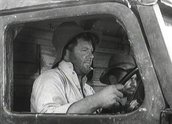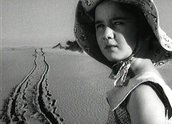


The Back of Beyond (1954)
Synopsis
Battling heat, dust, flood and sand, Royal Mail driver and everyman Tom Kruse completes the fortnightly run in his battered Leyland Badger, delivering mail, stores and supplies to the people along the 517 kilometre Birdsville Track in central Australia’s isolated outback.
The Back of Beyond is a feature-length documentary that recreates some of the characters and their stories on one of the world’s longest and most isolated mail runs.
Curator’s notes
Directed by John Heyer for the Shell Film Unit, The Back of Beyond is one of Australia’s most successful and affectionately remembered documentaries. It won the prestigious Grand Prix Assoluto at the Venice Film Festival, the overall prize for the best film across all categories. A beautiful and poetic film, the characters and situations are depicted with a sparkle and poignancy that elevate them into Australian folklore.
The film’s memorable real-life characters include the matter-of-fact modern bushman Tom Kruse; Bejah Dervish, the Afghan camel driver who ‘fought the desert by compass and by Koran’; William Henry Butler, Kruse’s record-playing companion; Jack the Dogger who kills wild dingoes; and old Joe the Aboriginal rainmaker. The Back of Beyond can be read like a collection of travelling vignettes along the Birdsville Track, embracing the experiences of these people and the isolated ‘never-never’ land they occupy.
Director John Heyer and his cinematographer Ross Wood had both worked for the Commonwealth Film Unit prior to joining Shell in 1948. Wood’s accomplished visual style and Heyer’s grasp of film language combine in The Back of Beyond to create some of the most iconic images of the Australian outback filmed in this period. The film reconfirms settler anxieties about the outback as a place of isolation, brutal indifference, danger and timelessness. At the same time it casts the characters in the landscape as survivors, people who endure, battlers with hearts of gold.
The film was tightly scripted by Heyer, and while he took inspiration from Tom’s experiences for most of the storyline, there are a number of scenes completely invented for dramatic effect – the legend of the lost children being the most obvious example. Conditions for filming were tough – the film unit traversed over 9,000 kilometres in a three-month shooting period in harsh terrain and extreme weather. Sand storms frequently interrupted filming and the fine dust which swept up from the desert interfered with equipment. Audio tapes of the soundtrack recorded on the shoot were rendered useless after sand scratched them and the whole film had to be revoiced in post-production. While it was common to post-sync dialogue and sound effects in documentaries at this time, Kruse and other participants in the film expected to hear their own voices up on screen and some of them were reportedly shocked to hear another person’s accent coming out of their own mouths.
Shell’s interest in the story of the Birdsville Track is linked to the importance of the postal and telecommunications industry and the development of infrastructure. In this way it shares similarities with the British documentary Night Mail (1936) directed twenty years earlier for the British GPO Film Unit by the ‘father of the documentary movement’ in Britain, John Grierson. Night Mail, like The Back of Beyond, used symbolic imagery, a poetic ‘voice-of-God’ narration, and a mail route to project its message of nation building. But also, like Night Mail, The Back of Beyond has outgrown its beginnings as a product of corporate or private enterprise and continues to resonate today.
As well as receiving the Grand Prix Assoluto at the Venice Film Festival, The Back of Beyond won awards at five international film festivals. Locally it was a hit as well. Some 750,000 people saw the film within the first two years of its release – a phenomenal figure for a local documentary. Aided considerably by the Shell Film Unit’s extensive distribution, exhibition and mobile film unit network, the film screened in town halls, theatrettes and cinemas nationwide to audiences ranging from young schoolchildren to adults. In the 1950s, most Australians wouldn’t have been anywhere near the ‘back of beyond’ or had first hand experience of the outback, so the film was an introduction to Australia’s centre. The film was screened for the first time at the Marree Town Hall on July 24 1954.
Recognising the value of moving image and associated materials as cultural and historical artefacts, the Shell Company of Australia has deposited a significant amount of its own film library holdings with the National Film and Sound Archive for preservation. Along with film and video material, the collection includes hundreds of associated publicity booklets, scripts, production stills, posters and film notes.
- Overview
- Curator’s notes
- Video 3 clips

- Principal credits
- Find a copy
- Comments 2
- Map
- Add your review



